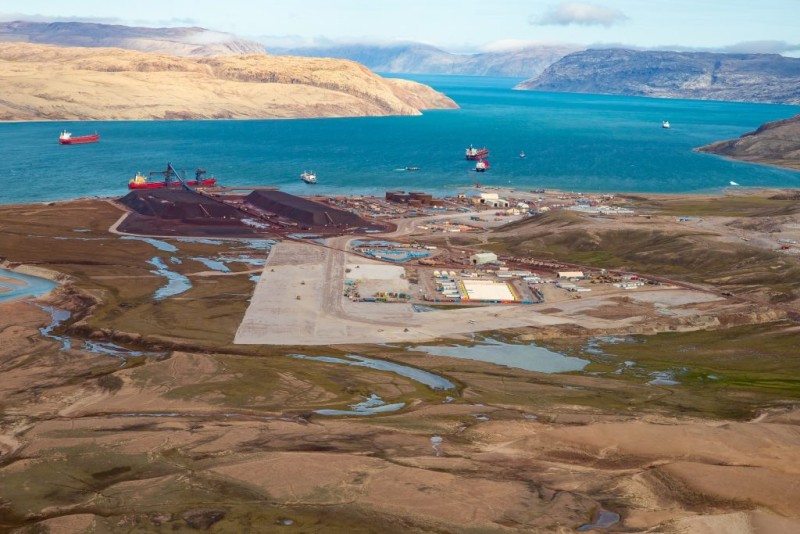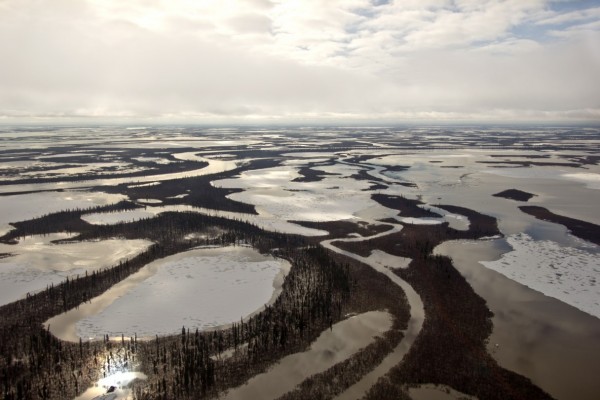The battle for Steensby Inlet is not over
Inuit hunters confront (another) iron mine expansion

Located on Northern Baffin Island, the Mary River iron mine currently produces 4.5 million tonnes of ore each year for European markets. Ore is shipped via a haul road from the mine to a port in Eclipse Sound, near the community of Pond Inlet, pictured here, on the north shore of Baffin Island. Photo courtesy Baffin Fisheries.
Inuit hunters from a small community in Nunavut are demanding a reassessment of a proposed expansion to an iron ore mine.
Baffinland Iron Mines intends to build a port and railway to Steensby Inlet, near the Inuit community of Igloolik, as part of a plan to quadruple production at its Mary River Mine. The port and railway were originally approved by the Government of Canada in 2012. However, the environmental assessment this approval was based on is now badly outdated. The Igloolik Hunters and Trappers Association believes that, at minimum, the project should be re-assessed before permits are issued.
The Mary River Mine
Located on Northern Baffin Island, the Mary River iron mine currently produces 4.5 million tonnes of ore each year for European markets. Ore is shipped via a haul road from the mine to a port in Eclipse Sound, near the community of Pond Inlet, on the north shore of Baffin Island.
Baffinland’s original proposal for the Mary River Mine included the port and railway at Steensby Inlet. However, soon after this proposal was approved in 2012, the company indicated that it lacked the capital to construct the port and railway. It submitted a revised proposal to ship much smaller quantities of ore through the Eclipse Sound port, with the aim of generating capital to one day build the Steensby port and rail. This scaled down version of the Mary River project, with shipping through Eclipse Sound, was approved in 2014. Now, over a decade later, the company wishes to expand production by proceeding with its original plan to ship ore through Steensby Inlet.
However, Inuit hunters are concerned that the environmental assessment of the Steensby Inlet port and rail is now badly outdated. In May, the Igloolik Hunters and Trappers Association and the Sanirajak Hunters and Trappers Association wrote a joint letter to the Nunavut Impact Review Board (NIRB), requesting a reassessment of the Steensby Inlet port and rail. The joint letter outlined the hunters’ concerns with the proposed mine expansion:
The Igloolik and Hall Beach HTAs are deeply concerned with Baffinland’s intentions to begin construction on the port and rail at Steensby Inlet in the near future. Sanirajak and Igloolik are both located near the potential southern shipping corridor for the Mary River mine, including the Steensby port/rail components. Inuit from both Sanirajak and Igloolik use Steensby Inlet and the surrounding area for many harvesting practices, including hunting (caribou, seals, walrus, whales, birds), fishing (char) and egg gathering. There is also a substantial commercial quota for Arctic char in the surrounding area. While this quota is not currently being used, our communities hope to benefit from this development opportunity someday in the future. The Sanirajak and Igloolik HTAs share many of the same concerns with Baffinland’s plans to build a port and railway in Steensby Inlet, especially the potential impacts on caribou, whale, seal, bird, and walrus hunting, as well as char fishing.
The letter noted particular concern with the effects of the proposed railway on Baffin Island’s caribou herds:
The [Hunters and Trappers Associations] are deeply concerned about dividing Baffin Island in half with Baffinland’s railway and tote road. This will stop caribou seasonal migrations from winter feeding grounds to spring calving grounds, as well as also migrations from caving grounds to winter grounds at late summer and fall season.
In a follow-up letter to the Minister of Crown-Indigenous Relations and Northern Affairs Canada, the Igloolik Hunters and Trappers Association reiterated its call for the Steensby port and rail to be reassessed.
This is not the first proposed expansion to the Mary River mine to encounter resistance from Inuit hunters. From 2016-2022 Baffinland attempted to double production at the Mary River Mine by increasing the amount of ore shipped through the port in Eclipse Sound. However, this proposed ‘Phase 2’ expansion was opposed by Inuit hunters in adjacent communities, including the Mittimatalik (Pond Inlet) Hunters and Trappers Organization. In February 2021, a group of hunters from Pond Inlet and Arctic Bay blockaded the air strip and haul road for two weeks, protesting the proposed expansion of the Mary River Mine. The Phase 2 expansion was rejected by the Government of Canada after an environmental assessment by the NIRB recommended the proposed expansion should not proceed. Following the government’s rejection of Baffinland’s proposal to expand shipping through Milne Inlet, the company announced that it would instead focus its efforts on building the Steensby Inlet port and rail.
Bird’s-eye view of the Mary River Mine near Pond Inlet. Photo courtesy Baffinland Iron Mines Corporation.
The need for a reassessment
There are several reasons why the Steensby Inlet port and railway should not proceed without further environmental assessment.
The Steensby Inlet area is critical for Inuit harvesting of wildlife. It is a huge biodiverse ecological zone (biosphere) involving land and ocean, a kind of Haida Gwai of the Arctic. For people in Igloolik it represents a key walrus and seal hunting area, with two critical eider duck nesting islands near the shipping routes, as well as many well used fishing sites. The railroad that would be built as the overland portion of the project will have to cross permafrost (the technical ‘innovation’ Baffinland would use to meet that challenge involves piling the train-bed up with over a meter of crushed rock). It will clearly affect caribou and other land-based species in the region.
According to federal law, if a mining project in Nunavut does not commence within five years of approval, a new assessment is required. Baffinland’s proposed port and railway to Steensby Inlet appears to circumvent this legal requirement based on a technicality: the port and rail are a component of the larger Mary River project, rather than a ‘project’ in and of itself.
However, the law also allows the Government of Canada to order a ‘reconsideration’ of an approved project in Nunavut if “circumstances relating to the project are significantly different from those anticipated at the time the certificate was issued.” When the Mary River project was first approved, Inuit in Igloolik anticipated that the project would begin in a timely fashion. It has now been well over a decade since approvals were issued and baseline conditions have changed.
The effects of the existing Mary River Mine are also more serious than Inuit expected. Scientific evidence and Inuit knowledge suggest that the project has negatively affected narwhal. For example, scientists have documented an increase in cortisol levels, a stress hormone, in narwhal in Eclipse Sound. Observations by hunters from Pond Inlet, as well as Baffinland’s own monitoring data, show significant declines in narwhals in the Eclipse Sound area since Baffinland began shipping operations. However, there is intensive disagreement over the cause of this change in narwhal distribution. While Inuit hunters and some scientists have attributed the decline in narwhal numbers to Baffinland’s shipping operations, the company blames increased killer whale predation and cruise ship traffic.
Inuit from Pond Inlet have also expressed serious concern with the amount of dust generated by the existing Mary River Mine. Hunters have observed snow dyed red from iron ore dust significant distances from the rock crusher and port at Eclipse Sound. Research by the Qikiqtani Inuit Association also shows that the project is emitting much more dust than was originally predicted. While the company has introduced some new mitigation measures, it has also dismissed Inuit concerns by arguing that dust emissions are not ‘significant.’ It is clear that the Inuit experience of the existing mine and transportation infrastructure has not positively impressed them; it is based on this that many have now become opposed to expansion.
Scenes of the area which will be affected by the proposed mine expansion. Photo by Judah Sarpinak.
Insufficient consultation
At a recent community meeting in Igloolik held by a panel of federal government officials, the local Hunters and Trappers Association forcefully expressed concern with Baffinland’s planned port and railway. “We are afraid that if six million tons a year is hurting wildlife in Eclipse Sound, 18 million tons being shipped every year through Steensby Inlet could be a disaster.”
The association demanded that the federal government instruct the NIRB to revisit the original certification:
Such a rethink would allow us and many other concerned communities to look over older research, add new information some of which comes from Baffinland’s own monitoring reports, and create a discussion of what changes need to be made to ensure less damage, have better monitoring, and have a project that does not become so huge it leaves us behind (in the dust!).
They argued that NIRB must hold the kind of ‘deep consultation’ that the Supreme Court of Canada has said may often be needed if it is clear that an Aboriginal right will be affected by a development project. Many members from the community spoke passionately—through anger and tears—about what the project would mean. There were only two local individuals who spoke in support, one of whom is working as a community consultant for the corporation.
Unfortunately, the meetings in Igloolik lasted only about three hours as the charter plane used by the federal panel had mechanical issues and the panel arrived in the late afternoon and had to leave in the early evening. Even the federal officials conceded that such a shortened visit was not nearly enough.
Sometime this winter the federal panel will revisit Igloolik likely while visiting a number of other Inuit communities. A variety of federal ministries—Fisheries and Oceans, Transport, Crown-Indigenous Relations and Northern Affairs—still need to provide licensing approvals for the railway, its bridges, the port and shipping plans. They appear to be assessing whether a full ‘deep consultation’ is required as well and, if so, what that would look like. In all likelihood this will not be a one day, fly in and out, visit.
Given the degree of concern from land-based families in the affected communities, we believe Canadians should pay attention and find ways to support Inuit in this consequential struggle. The main support for Igloolik has come from environmental NGOs like the World Wildlife Federation and Ocean’s North. This struggle does not seem to be on the agenda of any organization on the left: we write this as call to action.
Warren Bernauer is an Assistant Professor in the Department of Environment & Geography at the University of Manitoba.
Peter Kulchyski is a Professor in the Department of Indigenous Studies at the University of Manitoba.
Judah Sarpinak is the Chair of the Igloolik Hunters and Trappers Association.










